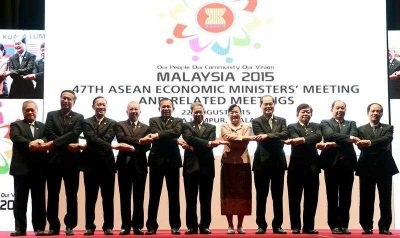
Southeast Asia looks set to usher in a new era of cooperation and stability following the ASEAN Foreign Ministers meeting in Kuala Lumpur, Malaysia in early August. But significant challenges to regional integration remain and the risk is that ambitious claims may outstrip the capacity to deliver.
Foreign ministers affirmed the commitment to establish the ASEAN Community by the end of the year, to be formalised by the ASEAN Heads of Government in November. The ASEAN Community will comprise the three pillars of the ASEAN Economic Community (AEC), the Political-Security Community (APSC) and Social-Cultural Community (ASCC), which were envisaged by the ASEAN Summits of 2003 and 2005.
The establishment of the ASEAN Community will represent the culmination of steps towards regional cooperation among the 10 member states of ASEAN that has been ongoing over the past several decades. From fragile beginnings in 1967, ASEAN has become a shining example of regional cooperation worthy of emulation.
With a combined gross domestic product of US$3 trillion in 2013, ASEAN now has the third largest GDP in Asia after China and Japan and a combined population of 600 million. And ASEAN GDP is projected to grow by more than 5 per cent per annum over the next five years, while intra-ASEAN trade is expected to exceed US$1 trillion. The establishment of the AEC will aim to create a single production and distribution base where products can be manufactured, distributed and sold anywhere in the region.
ASEAN will also seek to enhance connectivity throughout the region. An ASEAN highway network is a priority project, while maritime links will also be improved. Air services are being liberalised and plans are in place to enhance rail connectivity.
The emergence of the ASEAN Community is a giant leap forward from the 1960s when Southeast Asia was regarded as the Balkans of Asia, riven by inter-state and intra-state conflicts in the region. The cold war was raging and Southeast Asia was a zone of contention.
But since then, the situation in Southeast Asia has undergone a dramatic transformation. The original ASEAN Five (later six with Brunei) intensified their cooperative efforts in economic and political fields as set out in their Declaration of Bali Concord 1976, and later offered the hand of friendship to the four Indochina states. Vietnam subsequently joined ASEAN in 1995, followed by Laos and Myanmar in 1997 and Cambodia in 1999. The enlargement of ASEAN encouraged its leaders to make bold plans for the consolidation and development of the regional grouping. They envisioned the three Cs — an ASEAN Charter, an ASEAN Community and ASEAN Connectivity — to enhance ASEAN’s progress and prosperity.
But the challenge for ASEAN is that the ambitions of its proponents surpass their capacity to deliver. The focus of national governments will continue to be on building strong states and maintaining their hold on power. By aiming to establish the ASEAN Community and its three pillars by December 2015, ASEAN draws attention to current weaknesses in the level of regional integration.
Like other regional groupings, the reality facing ASEAN is that it is essentially a diplomatic community of policymakers, journalists and academics that has not sunk deep roots. ASEAN has been outstanding in promoting regional stability and security as well as promoting regional economic cooperation and development. The risk is that the extravagant claims for a Community (with a capital C) may go unfulfilled.
Yet the development of an ASEAN Community remains important as Southeast Asia is situated in the midst of major changes in global history. The United States is today the only superpower and has controlled the maritime space of the Indo-Pacific since 1945. A rising China, which has historically been focused westwards towards Central Asia, could emerge as a regional competitor for the United States in the decade ahead.
As China builds up its naval and air power, China’s presence in the East China Sea and South China Sea will increase. China is already the leading trading partner for states in Southeast Asia and is rapidly emerging as a major source of investment, tourism and business partnerships.
This means that China’s rise in the decades ahead will pose challenges for the region even as it creates opportunities. Policymakers in ASEAN states are concerned that China’s capacity to influence regional decisions will increase as China becomes more powerful.
States in the region will develop closer relations with China. Prospects for cooperation are strengthened by China’s enunciation of a Maritime Silk Road as a key objective, bringing with it the promise of enhanced mutual prosperity, increased trade and investment and greater regional peace and security. On the other hand, China’s extensive territorial claims in the South China Sea create the potential for conflict.
China has been unwilling to turn to international legal adjudication to settle conflicting maritime territorial claims, and its current land reclamation is far greater than that undertaken by any other claimant state. There is also a lack of progress in reaching an agreement with ASEAN on a Code of Conduct in the South China Sea. All this highlights ways in which China’s actions could negatively affect the ASEAN region and underscores the importance of continued efforts at enhanced regional cooperation as embodied in the creation of the ASEAN Community.
This article has been republished from eastasiaforum.org.